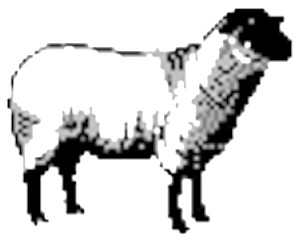 |
|
 |
Ontario Suffolk Sire
Reference
Association
|
| The History of
the Suffolk breed |
The original Suffolks were the result of crossbreeding Southdown rams on Norfolk Horned
ewes with the product of this cross being a great improvement over either one of the
parents. Although the Suffolk was a recognized breed as early as 1810, the flock book was
not closed until much later.
In 1930, Southdowns were described as large sheep without horns, dark faces and legs, fine
bones and long small necks. They were set low in front with high shoulders and light
forequarters; however, their rib area was more than adequate, rather broad in the loin
area, and were full in the thigh and twist.
Today's Suffolk derives its meatiness and quality of wool from the old original British
Southdown. The Norfolk Horned sheep, which is now extinct, were a wild and hardy breed.
They were blackfaced, light fleeced sheep and both sexes were horned.
The upland regions of Suffolk, Norfolk and Cambridge on the southeastern coast of England
are very rugged and forage is sparse. It was this dry, cold and windy area in which the
Norfolk breed adapted itself to travelling great distances for food, thereby developing a
superbly muscular body. It was said at that time of the Norfolk Horned, "their limbs
are long and muscular, their bodies are long and their general form speaks of activity and
strength." This breed and its crosses were valued highly both by farmers and
butchers. However, sheepmen of that day did not like the long legs, flat sides, nor wild
nature of the Norfolk Horned. They noted that Southdowns crossed with Norfolk produced a
progeny that reduced most of the criticisms of both breeds.
In 1886, the English Suffolk Society was organized to provide registry service and to
further develop the use of the Suffolk breed. Through careful selection and selective
breeding by many great English sheepmen, the Suffolks brought to this country retained the
qualities for which they were originally mated. The first Suffolks were brought into this
country in 1888 by Mr. G. B. Streeter of Chazy, New York. During a visit to England the
previous year, Mr. Streeter had been greatly impressed by Suffolk sheep.
These prize breeding animals had belonged to Joseph Smith of Hasketon, and one 21 month
old ewe weighed exactly 200 pounds when she came off the ship. A 9 month old ram weighed
195 pounds and in the spring of 1890, a 7 week old twin weighed 85 pounds. That spring
Streeter had a 200% lamb crop. The Suffolk did not make its appearance in the western
states until 1919. Three ewes and two rams had been donated by the English Suffolk Sheep
Society to the University of Idaho. One of the rams was to be sold at auction at the
National Ram Sale in Salt Lake City, Utah. Several leading sheepmen saw these sheep at the
sale and they were impressed with what they saw. After several rounds of bidding, the ram
was finally sold to Laidlaw and Brockie (developers of the Panama breed) of Muldoon,
Idaho, for $500. These men were so impressed with the offspring from their Suffolk ram
that they made several importations and were consistent buyers at the National Ram Sales.
Since that time the University of Idaho has played a great part in developing and
advancing the Suffolk breed in the western states.
Prior to World War II, the standard sheep was the "compressed" type with a heavy
wool covering over the face and legs. Since that time more practical sheepmen have become
aware of the advantages of an open faced breed and larger, meatier, growth derived
breeding stock. The commercial sheepman has also been aware of the economics associated
with rapid weight gains, less feed required for a pound of gain in weight and fewer days
until market weight is reached, less death loss risk and less interest on borrowed money.
The Suffolk breed has come a long way in its development and with the movement of the
Ontario Suffolk Sire Reference Association to continue to improve the quality of the breed
in North America we hope to see continued success.
Please Read On......